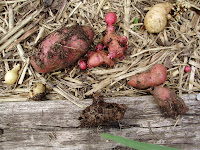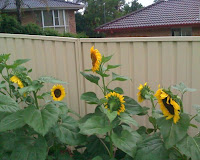Beans
We had two different bean varieties this summer. Rattlesnake beans, (below left) which are a climbing variety, where planted in the front garden to climb (and help cover) the bit of lattice underneath the front porch. The other variety is a butter bean called Sex Without Strings (below right), which is a bush variety and was planted into the main vegie patch in a couple of beds where we had space.
Both beans have gone well, with the Rattlesnake beans being the most productive. We only have two plants going, but have probably yielded just over a kilogram of beans so far. I've started to write down the weight of each harvest so we can have a better record.


The Sex Without Strings beans have been pretty productive per bush (we've got 4 going), but probably overall half the yield of the climbing beans. And true to the name, they are a lovely stringless butter bean. Both beans are very tasty and have been a regular addition to our dinners.
Basil
The tomatoes may have failed, but the basil has been going off! I transplanted around 6-7 basil seedlings in around the tomatoes and all have thrived, to the point that I had to seriously cut back some of them as they were smothering the tomatoes and capsicums.
The basil harvest has already been turned into a few jars of basil pesto, some basil butter, and some diced basil frozen into an ice cube tray for use later in the year. And there is still loads in the patch, which the bees love and we'll let go to seed.Lettuce
We've tried to get in to the habit of have a couple of lettuce plants on the go so that we've got lettuce for salads and meals. The best variety so far has been one of the freebies we received from Digger's Club, Australian Yellow Leaf (left).
It has bright yellow-green leaves and is a 'cut and come again' type of lettuce (non-hearting). Crisp and delicious. We've also been trying some heirloom varieties (middle and right) from a mixed pack. These have been nice, but in the crazy summer weather have tended to bolt to seed.
Strawberries
The strawberry patch was quite productive, and when we managed to beat the birds, slugs and labradors to them, we were treated to the tastiest luscious red fruit. I don't think that many made it to the kitchen, it was too tempting to eat them straight from the garden.
Rhubarb
The two rhubarb plants I put in during winter, which I was so worried I'd killed, sprang into life in spring producing thick stalks and enormous leaves that were so heavy some of the stalks were coming off from the weight of the leaves pulling them down.
We'd read that in the first year you shouldn't harvest any stalks, to let the plant establish and feed the crown, so we left it to grow. It has recently died down to nothing, which I'm hoping is just what rhubarb does and that with all the rain and humidity the crowns haven't rotted. The crowns do look very much like they did when I bought the dormant crowns, so hopefully they'll burst back in to life next spring.
Onions
Last winter, on the winter solstice, we planted a number of onions. We had two varieties of brown onion - Creamgold and Australian Brown - and one red onion. To experiment a bit with yield, we sowed a row of Australian Brown directly into the bed, and sowed the Creamgold and red onion in a seed-raiser tray, then transplanted them as soon as they were big enough to handle. The direct sown seeds certainly produced larger onions, but the others were a good medium-small onion.
We harvested them on the summer solstice (following the traditional planting guide of planting on the shortest day of the year and harvesting on the longest), which was just as well as we got them out before the deluge of summer rain hit. We strung them up in net under cover to dry out, and are now storing them inside in mesh bags. The yield was around 3.8kg of brown onions and 2.4kg of red onions.
Garlic
Like the onion, our garlic harvest went reasonably well. We got around 12 good sized cloves of red italian garlic, plus a few bonus garlics from the compost heap. Interestingly, none of the italian red garlics flowered. We had read that you wait for them to flower before harvesting, but they never did and the stalks just seemed to die off, so we pulled them out. One of the compost heap garlics did flower and the flower ends up producing seeds that look like tiny garlic cloves.
Garlic
Like the onion, our garlic harvest went reasonably well. We got around 12 good sized cloves of red italian garlic, plus a few bonus garlics from the compost heap. Interestingly, none of the italian red garlics flowered. We had read that you wait for them to flower before harvesting, but they never did and the stalks just seemed to die off, so we pulled them out. One of the compost heap garlics did flower and the flower ends up producing seeds that look like tiny garlic cloves.
We've probably got enough garlic to last us until next crop, when I think we'll plant some more of the italian red garlic and also try some of the seeds that we saved from the compost garlic.
Other successes in the garden have been the carrots, which continue to grow well though we need to remember to keep sowing more seed to get a progressive crop. The herbs in the front garden are also doing well and it is nice to be able to just duck out the front to snip a few when cooking.
Other successes in the garden have been the carrots, which continue to grow well though we need to remember to keep sowing more seed to get a progressive crop. The herbs in the front garden are also doing well and it is nice to be able to just duck out the front to snip a few when cooking.









































